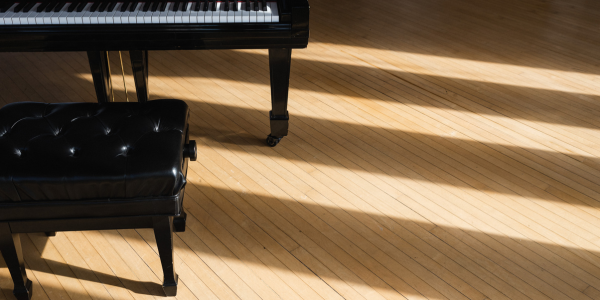
July 1, 1950
Émile Jaques-Dalcroze, whose work in music education made a lasting impression on the field, died in Geneva, Switzerland on this day. He completed studies in Geneva, Paris, and Vienna, working with the likes of Fauré, Delibes, and Bruckner among others. Early on, he became fascinated with rhythm, and while working at the Geneva Conservatoire, he began developing his influential method known as eurhythmics.1 His ideas were presented in 1905 at a conference in Switzerland, and from there, his work rapidly spread throughout the world.2 In addition to his work in music education, he composed a number of works for chamber and orchestral ensembles.
July 13, 1955
In Lenox, Massachusetts, the Beaux Arts Trio made their performance debut, beginning an international performance career lasting fifty-three years. The trio was originally formed with pianist Menahem Pressler, violinist Daniel Guilet, and cellist Bernard Greenhouse. Pressler remained the pianist throughout the group’s existence, however the string members included violinists Isidore Cohen, Ida Kavafian, Yung Uck Kim, and Daniel Hope as well as cellists Peter Wiley and Antonio Meneses. The Grammy-nominated trio recorded nearly the entire piano trio repertoire within the Western canon before dissolving in 2008.3 Enjoy this recording of the ensemble performing Maurice Ravel’s Piano Trio.
July 19, 1759
Viennese composer Marianna Auenbrugger was born in Vienna, Austria. Marianna and her sister Katharina Auenbrugger were accomplished keyboardists of the time; both studied under Antonio Salieri and were well known to Mozart and Haydn.4 Haydn, who dedicated multiple pieces to the sisters, once wrote about them stating, “the approval of the Demoiselles von Auenbrugger … is most important to me, for their way of playing and genuine insight into music equal those of the greatest masters. Both deserve to be known throughout Europe through the public newspapers.”5 Although Auenbrugger’s compositional output was exceptionally limited due to her short lifespan (1759-1782), her Sonata in E-flat Major is frequently performed. Enjoy this recording by pianist Olga Kleiankina.
July 22, 1987:
Natalie Hinderas, one of the first major Black classical concert pianists, died in Philadelphia, Pennsylvania on this day.6 Hinderas, originally from Oberlin, Ohio, was born into a family of musicians. Her father was a professional jazz musician and her mother was a classical pianist who taught at Fisk University.7 Hinderas studied at the Oberlin Conservatory before pursuing further studies with Olga Samaroff at Juilliard and Edward Steuermann at the Philadelphia Conservatory. She toured worldwide, performing throughout North America, Europe, and Africa. Among her significant accomplishments is a recording of works by African American composers such as R. Nathaniel Dett, George Walker, and William Grant Still.8 In addition to her remarkable performance career, Hinderas served as a professor at Temple University in Philadelphia from 1966-1987. Below is an excerpt from her celebrated recording which features George Walker’s Piano Sonata No. 1.
OTHER RESOURCES YOU MIGHT ENJOY:
- MAGAZINE ARTICLE: Adults on the Move with Dalcroze! by Jackie Edwards-Henry
- MAGAZINE ARTICLE: The Body and the Beat: Developing Rhythm through Mindful Movement by Lesley McAllister
- MAGAZINE ARTILCE: Always give your maximum: A conversation with Menahem Pressler by Jerry Wong
- MAGAZINE ARTICLE: The Ultimate Anti-Aging Hobby by Dolores Frederickson
- MICROCOURSE: Classical Era Music by Women Composers (from Hidden Gems: Four Centuries of Piano Music by Women Composers)
- COURSE: Hidden Gems: Four Centuries of Piano Music by Women Composers
- DISCOVERY PAGE: “Piano Inspires” Webinar: William Chapman Nyaho Interview
- MAGAZINE ARTICLE: Clavier Companion Teacher Profile: Madame Olga Samaroff by Nancy Bachus
- Use our search feature to discover more!
Not yet a subscriber? Join for only $7.99/mo or $36/yr.
Sources
- Lawrence W. Haward and Reinhard Ring, “Jaques-Dalcroze, Emile,” Grove Music Online, 2001; Accessed 11 July 2024, https://www.oxfordmusiconline.com/grovemusic/view/10.1093/gmo/9781561592630.001.0001/omo-9781561592630-e-0000014181.
- Haward and Ring, “Jaques-Dalcroze, Emile” Grove Music Online.
- Menahem Pressler, “Beaux Arts Trio,” Menahem Pressler’s Official Site, Accessed on July 11, 2024, https://menahempressler.org/beaux-arts-trio.html.
- Sylvia Glickman, “Auenbrugger [D’Auenbrugg], Marianna von,” Grove Music Online, 2001; Accessed 11 July 2024, https://www.oxfordmusiconline.com/grovemusic/view/10.1093/gmo/9781561592630.001.0001/omo-9781561592630-e-0000047884.
- Glickman, “Auenbrugger,” Grove Music Online.
- “Natalie Hinderas, 60; Played Classical Piano,” New York Times (New York City, NY), July 23, 1987. https://www.nytimes.com/1987/07/23/obituaries/natalie-hinderas-60-played-classical-piano.html.
- “Natalie Hinderas Collection,” Temple University Libraries, Temple University, Accessed July 10, 2024, https://library.temple.edu/finding-aids/natalie-hinderas-collection
- “Natalie Hinderas,” New York Times.
Glickman, Sylvia. “Auenbrugger [D’Auenbrugg], Marianna von.” Grove Music Online. 2001; Accessed 11 July 2024. https://www.oxfordmusiconline.com/grovemusic/view/10.1093/gmo/9781561592630.001.0001/omo-9781561592630-e-0000047884.
Haward, Lawrence W. and Reinhard Ring. “Jaques-Dalcroze, Emile.” Grove Music Online. 2001; Accessed 11 July 2024. https://www.oxfordmusiconline.com/grovemusic/view/10.1093/gmo/9781561592630.001.0001/omo-9781561592630-e-0000014181.
“Natalie Hinderas, 60; Played Classical Piano.” New York Times (New York City, NY), July 23, 1987. https://www.nytimes.com/1987/07/23/obituaries/natalie-hinderas-60-played-classical-piano.html.
“Natalie Hinderas Collection.” Temple University Libraries. Temple University. Accessed July 10, 2024. https://library.temple.edu/finding-aids/natalie-hinderas-collection.
Pressler, Menahem. “Beaux Arts Trio.” Menahem Pressler’s Official Site. Accessed on July 11, 2024. https://menahempressler.org/beaux-arts-trio.html.